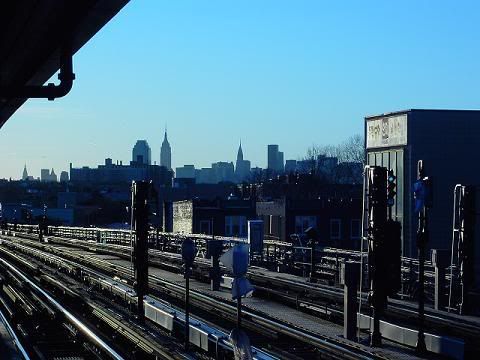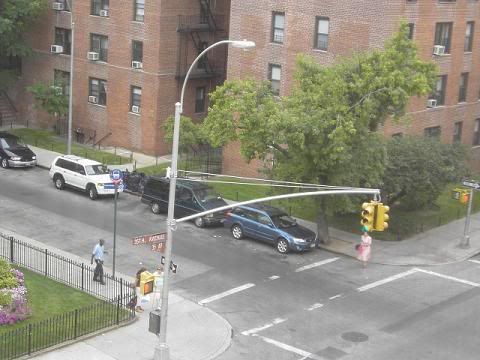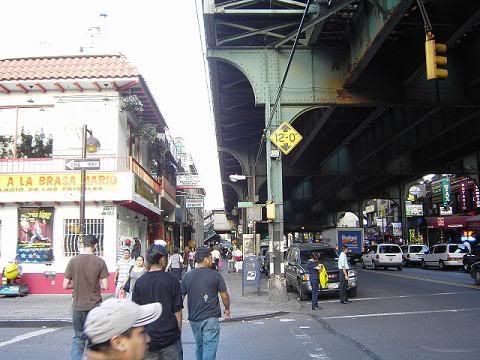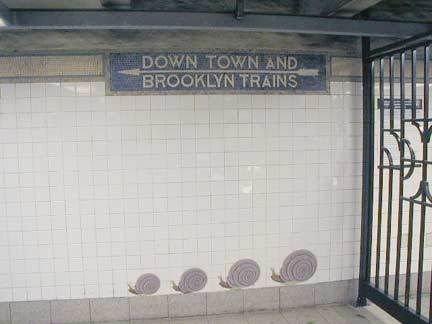Monday, October 8, 2007
Thesis and 2 Points
Introduced in 1965, the Immigration Reform Act had a lasting positive change on the neighborhood structure of Jackson Heights by creating a highly diverse population of immigrants.
2 Points of Evidence:
Vacant homes were sold to immigrant buyers who needed decent affordable housing near public transportation.
Immigrants helped recreate the business district of Jackson Heights by moving into the neighborhood and restarting businesses that were once abandoned.
Wednesday, October 3, 2007
Interview in Jackson Heights
1.) Do you live in Jackson Heights?
Yes.
2.) For how long?
About a year. A little less than a year.
3.) What area of J.H. do you live in?
I live on 103rd St. It's ok.
4.) What attracts you to J.H.?
It's always busy here, I like that. I lived in a boring place before. There's more here.
5.) Were you born in NYC?
No.
6.) How long ago did you move here and from where?
I came here when I was young, from Mexico.
7.) Which cultural group do you relate to?
Spanish.
8.) Do you feel any specific cultural group is more dominant here in J.H.?
No, it seems basically even I think. None more than the other.
9.) How do you feel different groups interact with one another here?
I think everyone gets along.
10.) What cultural changes have you noticed/ experienced while living in J.H.?
Not much, I don't think so.
11.) Have you experienced any cultural difficulty or conflict with another culture here?
None that I can think of. I'd say none.
12.) What have you noticed of the fluctuation of cultural groups here?
Seems level.
Monday, October 1, 2007
Questions of the Interview
2.) What area do you live in?
3.) Which culture do you most identify with?
4.) How long have you lived in Jackson Heights?
5.) How you experienced any cultural conflict while in Jackson Heights?
6.) What attracts you to this neighborhood?
7.) What changes have you experienced concerning the ethnic groups here?
8.) How do you feel all the different ethnic groups of Jackson Heights deal with each other(+/-)?
9.) Were you born in NY?
10.) What ethnic group do you feel is dominant in Jackson Heights?
Thursday, September 27, 2007
Historical II
NEAR EAST RELIEF BENEFIT.;
Referred to as the Blue and White Fete, a benefit was held for the Near East Relief in an attempt to relieve suffering for
Five tickets each costing one dollar were sent to each of the 1,000 families in the
For entertainment the
The Chairman of the committee, appointed by the
Historical II
Boundaries Keep Shifting, But Fears Remain the Same. New York Times.
The article discusses how the neighborhood borders of
Most of the complaints and expressed fear deal with the situations concerning drugs, prostitution, over-crowding, and noisy social clubs; few mention race as a problem.
At the beginning of the article, it is mentioned that the community of Woodside is predominately middle-class white and also mentioning that
Wednesday, September 19, 2007
7 Train

Yes, I did take this picture with my outdated camera… I know, it’s amazing.
A very important structure running through Queens from Manhattan Times Square to
Concerning the train I have witnessed a placard posted on the wall of the
In this photograph the train is absent, only leaving the tracks visible. These tracks are a technologically complex system of horizon strait metal and electrical systems used for monitored control. The train conductor also depends on a system of “red light stop, green light go” in the form of street lights for basic speed operation; also helping to keep the trains properly spaced. You can see from all the posts and plastic bags that this is an exciting place to wait for a train.
In the background you can see the
The picture took on a charming blue tint, reflecting the weather experienced that day. The sky was a lovely bright blue, and an equally pleasing temperature. I think the picture perfectly corresponds with the placid atmosphere of the day. Even looking at this picture now, I can feel relaxed from the tranquil coloring.
Research, Compilation
In the NYC borough of Queens, it has recently become the most ethnically diverse county in the
This immigrant movement is also reflected in the current demographic changes for the
* Jackson Heights CD403. 19 Sept 2007. http://64.233.169.104/search?q=cache:8BuiyWmfP38J:furmancenter.nyu.edu/CD403.pdf.pdf+jackson+heights+ethnic&hl=en&ct=clnk&cd=9&gl=us
** LayerInfo. 19 Sept 2007. http://nychanis.com/NYU/NYCHANIS/Map/Layerinfo.aspx
Miyares, Ines M. From exclusionary covenant to ethnic hyperdiversity in Jackson Heights, Queens. 2004. 19 Sept 2007 http://www.accessmylibrary.com/coms2/summary_0286-11987263_ITM
Tuesday, September 11, 2007
Historical Information 2
For
Historical Information 1
Miyares, Ines M. From exclusionary covenant to ethnic hyperdiversity in Jackson Heights, Queens. 2004. 11 Sept 2007 http://www.accessmylibrary.com/coms2/summary_0286-11987263_ITM
During the 1990s, Queens became the most ethnically diverse in the
Traffic Light

I know it’s basic and apparent, but I chose this traffic light.
I took this photo of a local light post/street light from my apartment window on the corner of 35th Ave and 81st St in fantastic Jackson Heights. It is located in the area known as the Garden Apartments and everything is relatively 50 years old and less. The street light is surrounded on all sides by 5-7 story magnificently decorated brick apartment edifices. The Garden Apartments get their name from the amount of garden walkways and amount of foliage along the sidewalks.
The traffic lights around the area are used on every intersection in my part of the Garden Apartments. The traffic lights are combined with the street lights as well as pedestrian walk signals and street signs. This avoids clutter and improves the appearance of the streets and sidewalks.
Although I have no posted placards or other solid proof that this was constructed after 1950, I think it’s safe to assume by its appearance that it was not built and placed in before that time. Also, the majority of the other structures in my area, including most of the buildings, are dated approximately during the 1960s.
According to what I have noticed online during my research for another class project* is that is was during the 1950s that the garden apartments were being constructed. I do not imagine that this traffic light was placed on a street before its construction had completed.
Another thing to keep in mind is that traffic lights in the 50s did not have this appearance. Currently the United States is utilizing the use of LED lights for better performance and longer life; I remember this being done around the 1990s. Another reason I like the lights on this street is the luminosity level from the LED lights. During the daylight they are able to remain bright enough that sunlight is not a problem to see the lights. While it is dark and I am waiting for the bus, the brightness of the lights is pretty (Yes, it is apparent I am easily entertained).
* Karatzas, Daniel. “
Wednesday, September 5, 2007
Descriptive Photo
Profile of Jackson Heights, NY - http://queens.about.com/od/neighborhoods/p/jacksonheights.htm
Never silent and always abusing your five senses is the multicultural neighborhood of Jackson Heights. The photograph of my area is on the corner of 81st Street and infamous Roosevelt Avenue. Standing there capturing the moment with my severely outdated, shoebox sized digital camera, I am calm. My mood is greatly affected by the surrounding weather and this is the perfect night to be out; a temperature that you can feel smoothly moving across your skin coaxing the little hairs to stand up. A clear sky marbled of a clean collection of shades of blue and bright white feathery clouds demands attention from everyone on the ground, reminding you to enjoy simple yet powerful beauty.
I can smell the rise of Colombian food drifting towards my general direction. Infusing the scents of perfected arroz con pollo, dry arepas, and addictive plantains, rarely picante, it forces my mouth to water. I can just taste the mutely sweet corn flavor of arepa de choclo gritty between my teeth.
Above struggles the 7 train, taking it’s time to ruin every cell phone conversation you plan to ever have underneath it. It continually shrieks on the metal ribbon tracks strait above Roosevelt, damaging the eardrums of everyone lucky enough to be in the area. The 7 train continues on, dragging its metallic heels loudly, flashing over us all with its departing shadow that now includes a different array of human collection.
The amount of traffic that swarms here will pinch your brain into a headache. Rusted vans delivering bread and shiny black cabs slowly making there way with passengers to the airport only occupy an incredibly small piece of this jumbled pie. The constant honking slips into sounding like excited barn animals.
Around me I can eavesdrop a variety of worldly linguistics spoken by people of all shapes, shades, and cultures. Dominated by Spanish and Hindi, a little of Chinese, English, Russian and Arabic is sometimes heard. The beautifully rolled Rs, rough throats, and universal laughter always make me feel relaxed and privileged to be there among the diversity of life. The people that quickly move by bring the neighborhood alive and give a better sense of reality.

Sunday, September 2, 2007
Forgotten NY
Forgotten-ny.com teaches it’s viewers of the unknown, lost, or covered up areas and items of
After browsing through the many site sections and pictures I had my favorite; Subways & Trains: The New Mosaics. This part of the site focuses on the beautifully eclectic artwork that adorns the subway walls. Made from thousands of tiles and a bit of other materials, the NYC subway system is adorned with the lovely, the odd, and the inspired. From hats to hanging clothes, snails to summer days, the art is captured and posted online to let people realize what they don’t notice as they might have hurried by. Or, for those that do notice, to become aware of what else is out among the tunnels. Art in itself is enjoyed by many, and to dedicate these subway walls to it is a wonderful way to uplift the mood of passerby’s in an otherwise hot and uncomfortable atmosphere.
According to the site, the unique use of tiles for art began in the 1910s by a man named Squire Vickers who was the subway art director and engineer. Since Vickers, the art has continued on by many different artists using many different styles. The history is also taken into account; dates and years are included in the description. By doing so, the reader is given an idea of the age of the subway, and also a look at the different popular styles and influence of the decades that have followed. Knowing the deep history of the tunnels can also influence a feeling of understanding and respect.
Not only does this section look at intricately thought out mosaics, but also the simple use of two or three colors for boarder stripes and signs. Letter style for signs is also recorded and explained to give the viewer a more detailed look from all angles.
Those who visit forgotten-ny.com will come away with a better understanding of why it’s important to remember much of what is now forgotten.

